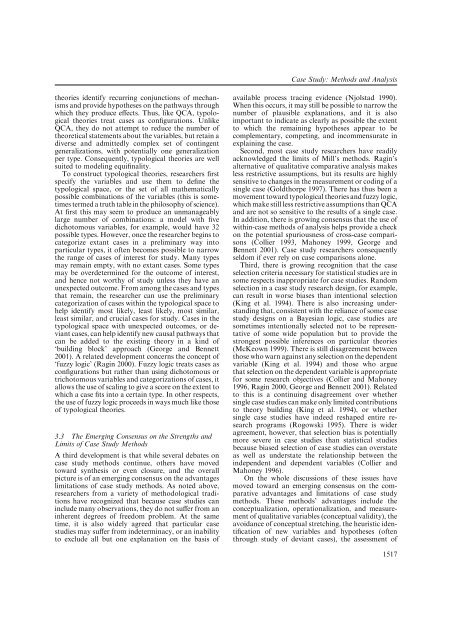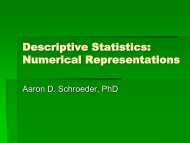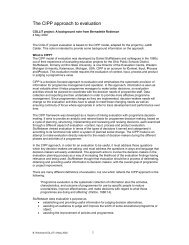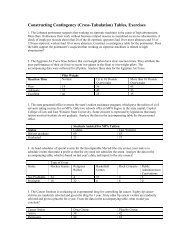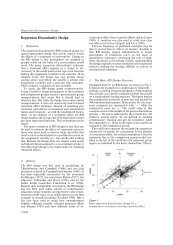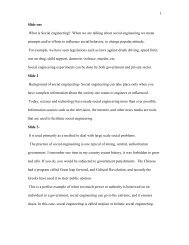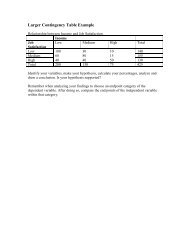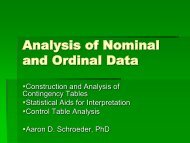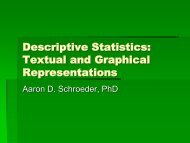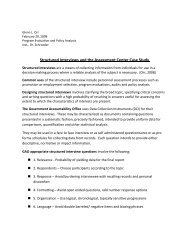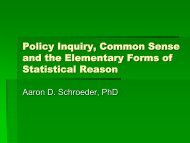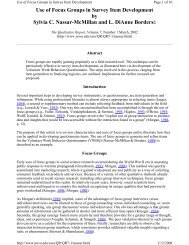Case Study: Logic
Case Study: Logic
Case Study: Logic
Create successful ePaper yourself
Turn your PDF publications into a flip-book with our unique Google optimized e-Paper software.
<strong>Case</strong> <strong>Study</strong>: Methods and Analysis<br />
theories identify recurring conjunctions of mechanisms<br />
and provide hypotheses on the pathways through<br />
which they produce effects. Thus, like QCA, typological<br />
theories treat cases as configurations. Unlike<br />
QCA, they do not attempt to reduce the number of<br />
theoretical statements about the variables, but retain a<br />
diverse and admittedly complex set of contingent<br />
generalizations, with potentially one generalization<br />
per type. Consequently, typological theories are well<br />
suited to modeling equifinality.<br />
To construct typological theories, researchers first<br />
specify the variables and use them to define the<br />
typological space, or the set of all mathematically<br />
possible combinations of the variables (this is sometimestermedatruthtableinthephilosophyofscience).<br />
At first this may seem to produce an unmanageably<br />
large number of combinations: a model with five<br />
dichotomous variables, for example, would have 32<br />
possible types. However, once the researcher begins to<br />
categorize extant cases in a preliminary way into<br />
particular types, it often becomes possible to narrow<br />
the range of cases of interest for study. Many types<br />
may remain empty, with no extant cases. Some types<br />
may be overdetermined for the outcome of interest,<br />
and hence not worthy of study unless they have an<br />
unexpected outcome. From among the cases and types<br />
that remain, the researcher can use the preliminary<br />
categorization of cases within the typological space to<br />
help identify most likely, least likely, most similar,<br />
least similar, and crucial cases for study. <strong>Case</strong>s in the<br />
typological space with unexpected outcomes, or deviant<br />
cases, can help identify new causal pathways that<br />
can be added to the existing theory in a kind of<br />
‘building block’ approach (George and Bennett<br />
2001). A related development concerns the concept of<br />
‘fuzzy logic’ (Ragin 2000). Fuzzy logic treats cases as<br />
configurations but rather than using dichotomous or<br />
trichotomous variables and categorizations of cases, it<br />
allows the use of scaling to give a score on the extent to<br />
which a case fits into a certain type. In other respects,<br />
the use of fuzzy logic proceeds in ways much like those<br />
of typological theories.<br />
3.3 The Emerging Consensus on the Strengths and<br />
Limits of <strong>Case</strong> <strong>Study</strong> Methods<br />
A third development is that while several debates on<br />
case study methods continue, others have moved<br />
toward synthesis or even closure, and the overall<br />
picture is of an emerging consensus on the advantages<br />
limitations of case study methods. As noted above,<br />
researchers from a variety of methodological traditions<br />
have recognized that because case studies can<br />
include many observations, they do not suffer from an<br />
inherent degrees of freedom problem. At the same<br />
time, it is also widely agreed that particular case<br />
studies may suffer from indeterminacy, or an inability<br />
to exclude all but one explanation on the basis of<br />
available process tracing evidence (Njolstad 1990).<br />
When this occurs, it may still be possible to narrow the<br />
number of plausible explanations, and it is also<br />
important to indicate as clearly as possible the extent<br />
to which the remaining hypotheses appear to be<br />
complementary, competing, and incommensurate in<br />
explaining the case.<br />
Second, most case study researchers have readily<br />
acknowledged the limits of Mill’s methods. Ragin’s<br />
alternative of qualitative comparative analysis makes<br />
less restrictive assumptions, but its results are highly<br />
sensitive to changes in the measurement or coding of a<br />
single case (Goldthorpe 1997). There has thus been a<br />
movementtowardtypologicaltheoriesandfuzzylogic,<br />
which make still less restrictive assumptions than QCA<br />
and are not so sensitive to the results of a single case.<br />
In addition, there is growing consensus that the use of<br />
within-case methods of analysis helps provide a check<br />
on the potential spuriousness of cross-case comparisons<br />
(Collier 1993, Mahoney 1999, George and<br />
Bennett 2001). <strong>Case</strong> study researchers consequently<br />
seldom if ever rely on case comparisons alone.<br />
Third, there is growing recognition that the case<br />
selection criteria necessary for statistical studies are in<br />
some respects inappropriate for case studies. Random<br />
selection in a case study research design, for example,<br />
can result in worse biases than intentional selection<br />
(King et al. 1994). There is also increasing understanding<br />
that, consistent with the reliance of some case<br />
study designs on a Bayesian logic, case studies are<br />
sometimes intentionally selected not to be representative<br />
of some wide population but to provide the<br />
strongest possible inferences on particular theories<br />
(McKeown 1999). There is still disagreement between<br />
those who warn against any selection on the dependent<br />
variable (King et al. 1994) and those who argue<br />
that selection on the dependent variable is appropriate<br />
for some research objectives (Collier and Mahoney<br />
1996, Ragin 2000, George and Bennett 2001). Related<br />
to this is a continuing disagreement over whether<br />
single case studies can make only limited contributions<br />
to theory building (King et al. 1994), or whether<br />
single case studies have indeed reshaped entire research<br />
programs (Rogowski 1995). There is wider<br />
agreement, however, that selection bias is potentially<br />
more severe in case studies than statistical studies<br />
because biased selection of case studies can overstate<br />
as well as understate the relationship between the<br />
independent and dependent variables (Collier and<br />
Mahoney 1996).<br />
On the whole discussions of these issues have<br />
moved toward an emerging consensus on the comparative<br />
advantages and limitations of case study<br />
methods. These methods’ advantages include the<br />
conceptualization, operationalization, and measurement<br />
of qualitative variables (conceptual validity), the<br />
avoidance of conceptual stretching, the heuristic identification<br />
of new variables and hypotheses (often<br />
through study of deviant cases), the assessment of<br />
1517


